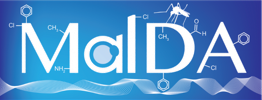Exploring a Tetrahydroquinoline Antimalarial Hit from the Medicines for Malaria Pathogen Box and Identification of its Mode of Resistance as PfeEF2.
Journal:
ChemMedChem, Volume: 17, Issue: 22Abstract:
New antimalarial treatments with novel mechanism of action are needed to tackle Plasmodium falciparum infections that are resistant to first-line therapeutics. Here we report the exploration of MMV692140 (2) from the Pathogen Box, a collection of 400 compounds that was made available by Medicines for Malaria Venture (MMV) in 2015. Compound 2 was profiled in in vitro models of malaria and was found to be active against multiple life-cycle stages of Plasmodium parasites. The mode of resistance, and putatively its mode of action, was identified as Plasmodium falciparum translation elongation factor 2 (PfeEF2), which is responsible for the GTP-dependent translocation of the ribosome along mRNA. The compound maintains activity against a series of drug-resistant parasite strains. The structural motif of the tetrahydroquinoline (2) was explored in a chemistry program with its structure-activity relationships examined, resulting in the identification of an analog with 30-fold improvement of antimalarial asexual blood stage potency.
